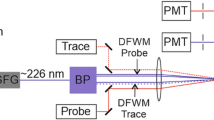Abstract
The possibility of detecting OH radicals and stable paramagnetic NO species in flames using the effect of rotation of the polarization plane of terahertz radiation (1–10 THz) in a magnetic field (Faraday effect) was experimentally demonstrated. Experimental data on detection of NO in a cell and OH radicals in an atmospheric-pressure H2/O2/N2 flame using this method are given. The proposed method can be used to study highly scattering media which are opaque in the visible region, for example, dusty or sooty flames.
Similar content being viewed by others
References
H. M. Pickett, R. L. Poynter, E. A. Cohen, M. L. Delitsky, J. C. Pearson, and H. S. P. Muller, “Submillimeter, millimeter, and microwave spectral line catalog,” J. Quant. Spectrosc. Rad. Transfer, 60, 883–890 (1998); http://spec.jpl.nasa.gov/home.html.
R. A. Cheville and D. Grischkowsky, “Far-infrared terahertz time-domain spectroscopy of flames,” Opt. Lett., 20, 1646–1648 (1995).
R. A. Cheville and D. Grischkowsky, “Observation of pure rotational absorption spectra in the ν 2 band of hot H2O in flames,” Opt. Lett., 23, 531–533 (1998).
R. A. Cheville and D. Grischkowsky, “Far-infrared foreign and self-broadened rotational linewidths of hightemperature water vapor,” J. Opt. Soc. Amer. B., 16, 317–322 (1999).
M. R. Stringer, J. Bassi, R. E. Miles, Y. Zhang, and K. Ozanyan, “THz spectroscopy through a highpressure combustion system,” in: 33rd Int. Conf. Infrared, Millimeter and Terahertz Waves (IRMMW-THz 2008) (2008), pp. 1–2.
N. G. Gavrilov, B. A. Knyazev, E. I. Kolobanov, V. V. Kotenkov, V. V. Kubarev, G. N. Kulipanov, A. N. Matveenko, L. E. Medvedev, S. V. Miginsky, L. A. Mironenko, A. D. Oreshkov, V. K. Ovchar, V.M. Popik, T. V. Salikova, M. A. Scheglov, S. S. Serednyakov, O. A. Shevchenko, A. N. Skrinsky, V. G. Tcheskidov, and N. A. Vinokurov, “Status of the Novosibirsk high-power terahertz FEL,” Nucl. Instrum. Meth. Phys. Res. A, 575, 54–57 (2007).
A. Hinz, W. Pfeiffer, W. Bohle, and W. Urban, “Midinfrared laser magnetic resonance using the faraday and voigt effects for sensitive detection,” Molec. Phys., 45, No. 6, 1131–1139 (1982).
Author information
Authors and Affiliations
Corresponding author
Additional information
__________
Translated from Fizika Goreniya i Vzryva, Vol. 46, No. 2, pp. 36–41, March–April, 2010.
Rights and permissions
About this article
Cite this article
Chesnokov, E.N., Aseev, O.S., Korobeinichev, O.P. et al. Using terahertz radiation to detect OH radicals and NO molecules in flames. Combust Explos Shock Waves 46, 149–153 (2010). https://doi.org/10.1007/s10573-010-0023-7
Received:
Published:
Issue Date:
DOI: https://doi.org/10.1007/s10573-010-0023-7



